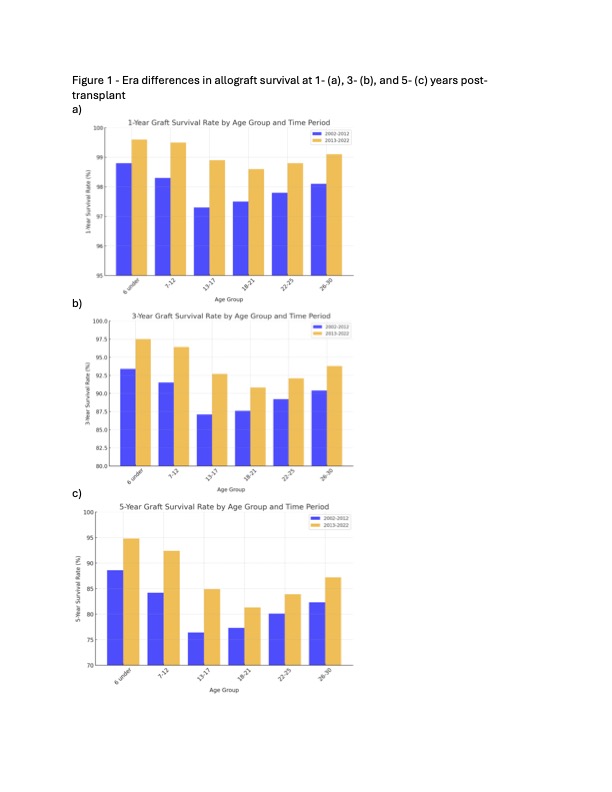Still left behind – Kidney transplant outcomes in adolescents and young adults
Priya Verghese2, Eric G Benz1, Joseph Fishbein2, Margret Bock1.
1Pediatrics, University of Colorado, Aurora, CO, United States; 2Pediatrics, Northwestern University, Chicago, IL, United States
Adolescent and young adult (AYA) kidney transplant (KT) recipients have more graft loss compared to other age groups, often during the time of transition from pediatric to adult care teams. Academic societies including the American Academy of Pediatrics and the American Society of Transplantation have published guidelines and educational tools to ensure effective transitions to adult care. We aimed to investigate whether patient outcomes in AYA KT recipients have changed since the adoption of transition to adult care curricula in many transplant programs across the United States.
We evaluated 48,436 patients 30 years and younger who received KT between 2002 and 2022, as recorded in the Scientific Registry of Transplant Recipients (SRTR) database. We used multivariable cox proportional hazard analysis to evaluate the association of age and risk for death-censored allograft failure at 1-year, 3-year, and 5-year post-transplant. We used age group 26-30 years as reference. We also analyzed allograft survival by era, pre- (2002-2012) and post- (2013-2022) transition curricula.
There were 2504 allograft failures over a mean follow up time of 3.88 years in the post-transition curricula era. Risk of allograft failure at 3 years (HR 2.00 (1.68-2.37)) and 5 years HR 1.88 (1.64-2.15)) post-transplant was highest in the 18-21 age group from 2013-2022 (Table 1). Graft survival improved across historical cohorts, with best outcomes in the current era (Figure 1). Regardless of era of transplantation, the 1-, 3-, and 5-year graft survival remained lowest in the 18-21 year old age group, as compared to all others (Figure 1). The current era of transplantation saw a significantly higher improvement in allograft survival from the prior era (2002-2012) in the 13-17 year old age group compared to the 18-21 year old age group at 3 years post-transplant. Additionally, there was a significantly higher improvement in allograft survival from the prior era in the 7-12 and 13-17 year old age group compared to the 18-21 year old age group at 5 years post-transplant.


AYA kidney transplant recipients in the 18-21 year age group continue to have the highest risk of allograft failure despite efforts over the last decade to improve transitions from pediatric to adult care. Additional prospective studies are needed to determine ways to improve both short- and long-term outcomes in this high risk population.
[1] Allograft Survival
[2] Adolescence
[3] Kidney
[4] Transition